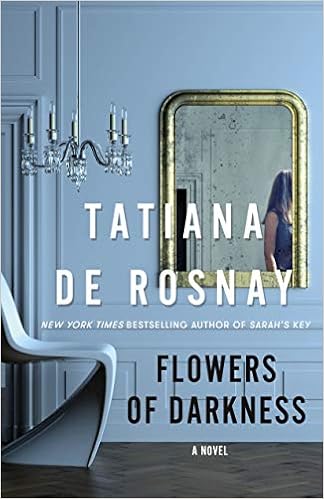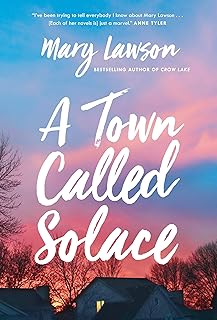2 Stars
I panned Tatiana de
Rosnay’s 2018 novel
The Rain Watcher but
thought I’d give the author another chance so I requested a digital galley of
her latest,
Flowers of Darkness. I’m afraid this one is not an improvement.
The novel is set in
Paris in the near future after the destruction of the Eiffel Tower, “the devastation
of the Piazza San Marco, bombed-out Big Ben, and the obliteration of the
Sistine Chapel.” Clarissa Katsef, a
novelist who writes in both English and French, moves into an ultra-modern,
high-tech apartment in a complex owned by C.A.S.A. (Center for Adaptive Synergy
for Artists). She is looking for a
refuge after a betrayal by her second husband, but she becomes uncomfortable
when she feels herself being constantly watched by “the tiny cameras in each
room, like little black eyes, always following her around.” She sets out to find out why her privacy is
being invaded and enlists the help of her granddaughter Andy to help her.
This book is a
commentary on climate change. For
example, there is more than one comment about the plight of the planet. Abby laments, “’Look at what’s happening to
the planet. Look what we did to it. Look what’s left of the forests. . . . Heat
waves, floods, hurricanes, pollution.” Clarissa ponders “The perpetual heat waves, scorching
summers, scarcity of water, brutal storms, end of natural pollination, and slow
extinction of insects.”
Artificial
intelligence is another target. The roles
of robots in health care and security are mentioned, but they also take care of
most human needs, even pleasure. Clarissa
foresees a time when “’we could be forced to appreciate a fake culture entirely
conceived and controlled by machines. We
will no longer have any choice at all.
For a long time, we’ve been getting those notifications telling us, “You
liked so-and so’s book, so then read thingy’s one.” But what’s ahead could be even worse. Art, in each and every form, could be
anticipated, made to order. Humans will
stop creating, stop imagining. The end
of surprises, make-believe, the end of possibilities, of the unexpected. On every front, it’ll be the victory of
robots.’”
Another complaint
Clarissa has is that people do not read books.
In one paragraph, this is mentioned three times: “Hardly anyone read books anymore . . . it seemed
no one yearned for books anymore. No one
bought them . . . it appeared no one had the time to read or write anymore.” Later, she goes on and on about how “Pictures
took precedence over words. No one read
newspapers. People watched videos . . .
Literature no longer held its own . . . People preferred to come and listen to
the writer, to applaud the writer as he or she read from his or her book, and
no longer purchased signed copies. Reading
was no longer comforting. Reading no
longer helped to heal.” She worries
about piracy, which is understandable, but she just seems to object to people
reading books on devices. Reading an
ebook doesn’t qualify as reading? So I
didn’t really read this book?!
The author, who has
written books in both French and English, seems obsessed with people who have “hybrid
brains” which she defines as people “who live and who dream in two different
tongues.” Clarissa is simultaneously writing
two versions of a book, one in English and one in French. The author seems to suggest that people who
are bilingual are more creative. But
what does bilingualism have to do with creativity in non-verbal arts? The creativity
of bilingual sculptors and painters and musicians would be of more interest
than that of monolingual sculptors, painters and musicians?
It is difficult to
connect with Clarissa. She is in her late
sixties, but she acts so immaturely. She
needs to wear “high-heeled rock-star boots” which she admits are inappropriate for
her age so she can feel “badass”? Over and over again, it is mentioned that she
is particularly interested in the relationship between writers and their living
environments, yet she doesn’t check out her new apartment before moving in. After she moves in “she suddenly realized she
had moved into a dwelling she had never seen beforehand”?! She “blindly” signs a contract and even allows
C.A.S.A. to monitor her health and only after moving in does she look up “the
meaning of C.A.S.A.”? She starts to feel
tired and thinks she should “slow down, write less and with less passion” yet
she is never shown writing? Her most
successful novel is improbably titled Topography
of Intimacy?!
Other characters are
unconvincing as well. Fourteen-year-old
Andy seems too mature for her age, giving advice to her grandmother. Meanwhile, her forty-four-year old mother Jordan
seems immature. For instance, Jordan is
jealous of her cousins who received an inheritance from their aunt?! Clarissa’s father calls two of his
granddaughters “sluts” and “tarts” and “twits”?!
Writing style is a
major problem. It is stiff and flat,
like something that could have been written by a robot. I kept thinking it had been poorly translated
into English. There is so much awkward
phrasing: “single tawdry cotillion” and “bloody
pearls on a steadfast necklace of violence” and “sturdy, slightly stubby-legged
outline” and “prodigious calm” and “lacustrine ballet” and “infinitesimal dark
zone behind Mia White’s luminous smile” and “the choppy outcome of Aunt Serena’s
will” and “imperious sensation.” A wedding band is a “jewel”? A
person who is understanding is “marvelously comprehensive”? A person who remains expressionless is
described as not losing “countenance”?
The author seems to want to impress with her vocabulary but she uses
words incorrectly.
It is not only the
diction that is an issue. Short, choppy
sentences abound. Then there are the
long series of interrogative sentences: “Had
he gone crazy? After everything he’d
done? Did he really think she was going
to shut up and stick around? Act like
nothing had happened?” Exclamatory
sentences are also overused: “Seriously,
she looked like a lunatic! A madwoman!” Transitions are often missing so paragraphs
are disjointed: “Jordan had lost many
friends in the attack. Clarissa said
good-bye to her daughter, and then asked Andy to go dry her hair. The president’s face appeared on the screen.” Why is
Mia White always spoken of as Mia White?
Her surname has to be given even though there is no other Mia in the
narrative?
There are events that
make no sense or are left unexplained.
Why are we only told Clarissa’s pseudonym and not her real name? What happened to Jim? Why does Clarissa rush to London because of
concerns about her father only to return home immediately? What is the purpose of the squabble over
inheritance? Who is responsible for the
destruction of European landmarks? Andy
can roam around the C.A.S.A. complex, where surveillance is everywhere, and not
be observed? It is possible to bargain
with a robot? A cat joins a woman taking
a shower and “installed himself on her thighs”?
What are “Brexit’s unsettling consequences, steeped in complication”? To re-create “vanished beaches swallowed up
by the rising sea level,” people are trying “to find sand, which had become so
rare”?
Reading this book was
laborious. Neither the plot nor the
characters nor the style is noteworthy in a positive way.
Note: I received an eARC from the publisher via
NetGalley.






